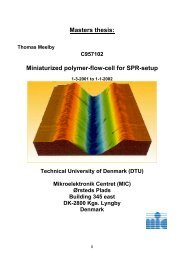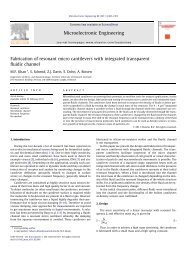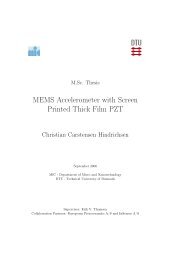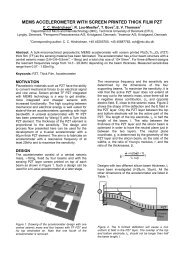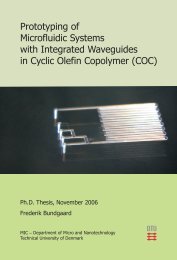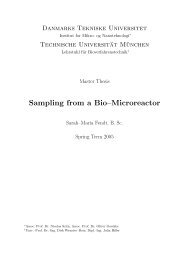Development of a Oxygen Sensor for Marine ... - DTU Nanotech
Development of a Oxygen Sensor for Marine ... - DTU Nanotech
Development of a Oxygen Sensor for Marine ... - DTU Nanotech
You also want an ePaper? Increase the reach of your titles
YUMPU automatically turns print PDFs into web optimized ePapers that Google loves.
2.3. SUMMARY 11<br />
<strong>of</strong> oxygen molecules, which is similar to that <strong>of</strong> a Clark sensor (more about<br />
this in Chapter 3). However the way the ISFET detects it, is by determining<br />
the surface potential at the insulator/electrolyte interface.[19] Also in<br />
the case <strong>of</strong> the pH-ISFET the surface <strong>of</strong> the gate oxide will contain OH −<br />
molecules, which can be protonated and deprotonated, so when the gate oxide<br />
contacts an aqueous solution, the change in pH will cause the silicon<br />
surface potential to change as well.<br />
The advantages <strong>of</strong> the ISFET is that the CMOS and MOSFET are tried<br />
and used technologies. However chemical sensors are still a relative new area<br />
<strong>for</strong> this to be used in, and as such suffers from ’child’-diseases.<br />
Disadvantages have included light sensitivity, lack <strong>of</strong> solid-state reference<br />
electrodes, and packaging integrity difficulties. [20]<br />
2.3 Summary<br />
While both the Optodes and the ISFET are viable ways <strong>of</strong> creating a oxygen<br />
sensor, both had certain distinct disadvantages that made the Clark type a<br />
better choice. However <strong>of</strong> the two, the optodes might in the future become a<br />
superior solution, once the problems with size and power supply have been<br />
solved.



